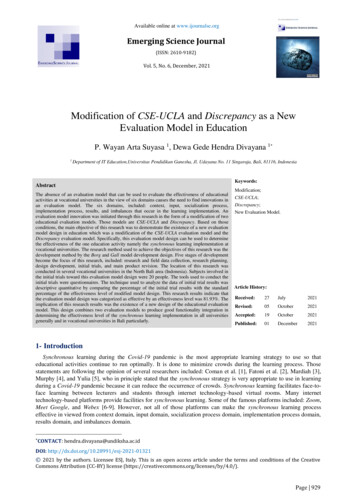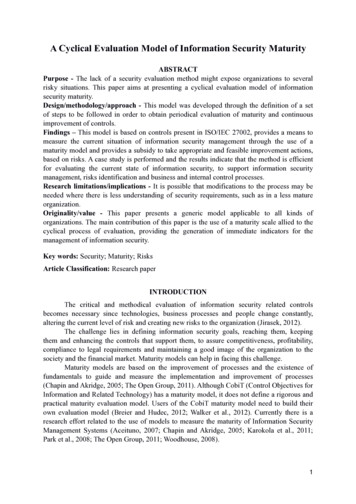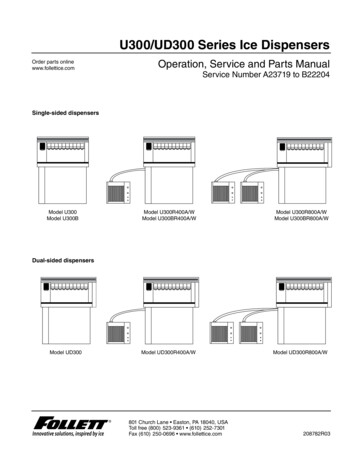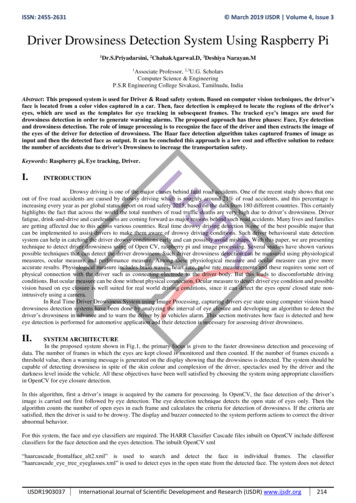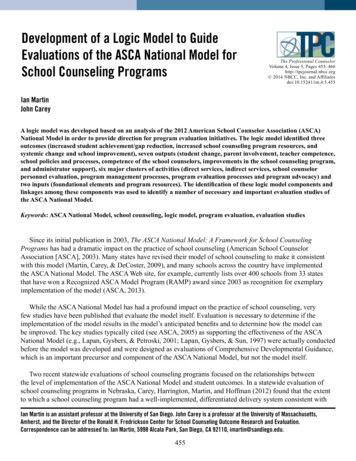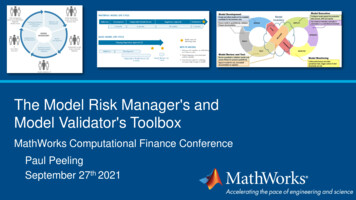
Transcription
MÄLARDALEN UNIVERSITYSCHOOL OF INNOVATION, DESIGN AND ENGINEERINGVÄSTERÅS, SWEDENThesis for the Degree of Master of Science in Engineering - Software Engineering30.0 creditsAN EVALUATION OF MODEL-BASED TESTINGIN INDUSTRIAL PRACTICE: FROM SYSTEMMODELLING TO TEST GENERATIONAliya Hussainahn16022@student.mdh.seExaminer: Professor Jan CarlsonMälardalen University, Västerås, SwedenSupervisor: Dr. Eduard Paul Enoiu and Dr. Saurabh TiwariMälardalen University, Västerås, SwedenCompany Supervisor: Dr. Jagadish SuryadevaraVolvo Construction Equipment, Eskilstuna, SwedenDate: 09/19/20181
AbstractVehicular systems have become intensively sophisticated and their software content has increased swiftly in this era.While developing the vehicular software, the requirements which should be satisfied are more complex in comparisonto other types of software. As vehicular systems interact with physical processes, the high reliability of the system isalways demanded. This is making testing a difficult but necessary step in developing reliable systems. Due to thecompetition and customer demands companies tends to update the software systems of their products as often aspossible. Such demands put increased pressure on making testing more efficient and cost-effective. Traditionally,software testing is performed manually and in an ad-hoc manner. Moreover, manual testing becomes costlier whensoftware is updated often. Hence there is the need for using techniques which can complement such manual techniques.Model-based testing (MBT) is a test automation technique which promises to increase reliability, understandability,and maintainability of test cases by the use of test models, automatic test generation and execution. MBT is the processof test generation from design models of the system requirements and functionality. There are studies in the literatureshowing initial results on the advantages of using MBT with some promising results. Such promises are inspiringcompanies to take an interest in adopting the MBT approach. This thesis aims to evaluate the use of MBT in industrialpractice and investigates the automated testing approach and its applicability in the context of Volvo CE.The results of this thesis show that structural and behavior models can be created based on functional architectureand requirements of a real subsystem provided by Volvo-CE. These models are generated in Conformiq Creator MBTtool. Test cases are generated using different model coverage criteria. The results suggest that activity and structurediagrams, developed using MBT, are useful for describing the test specification of an accelerator pedal controlfunction subsystem. The use of MBT results in less number of test cases compared to manual testing performed byindustrial engineers for these subsystems. We showed that MBT can be used for system modelling and test casegeneration in the vehicular domain.2
AcknowledgmentWith the name of Allah, the most gracious and merciful. I have no words to thank ALLAH and the guidedPanjatan-Pak for their countless blessings and support bestowed upon me throughout my thesis journey.I would like to dedicate this research to my Parents, who stood by me in thick and thin. Without theirsupport and confidence in me, it was not possible for me to study in a foreign country.I would like to extend my deep gratitude and appreciation to my supervisors Dr. Eduard Paul Enoiu andDr. Saurabh Tiwari for providing me patient guidance, enthusiastic encouragement, useful critiques andendless help at each step of the research study. I would also like to thank Dr. Jagadish Suryadevara forgiving me a chance to work on my thesis in collaboration with Volvo. I would like to acknowledge thetesting team at VCE for their help and feedback.I would also like to express my thanks to my examiner Professor Jan Carlson for providing his feedbackduring the research study.Finally, I thank my siblings for providing me with their emotional support, love, and encouragementthroughout my study career. This journey provided me with endless memories and was indeed a lifetimeexperience.3
Contents12Introduction . 71.1Problem Formulation . 71.2Scope of the Thesis . 81.3Outline of the Thesis . 8Background . 92.1Software Testing . 92.2Black Box Testing . 92.3Model-Based Testing. 92.3.1Model-Based Testing Process . 102.3.2Perceived Advantages of Model-Based Testing . 122.3.3Perceived Disadvantages of Model-Based Testing. 132.43Related Work . 14Conformiq Creator . 173.1Model Creation . 173.2Generating Test Cases . 194Functional Testing at Volvo CE . 205Research Methodology . 225.16Case Study Design . 22Evaluation Results. 256.1System Under Test 1: Accelerator Pedal CAF (Complete Analysis Function) . 256.1.1Creation of Models . 276.1.2Test Cases Generation . 336.1.3Model Validation . 396.1.4Results of MBT and Manual Testing Comparison . 406.2System Under Test 2: Brake Pedal CAF (Complete Analysis Function) . 426.2.1Creation of Models . 446.2.2Test Cases Generation . 476.2.3Model Validation . 526.2.4Results . 527Answering Research Questions . 548Conclusion . 569Limitation and Future Work . 564
References . 58Disclaimer . 59List of FiguresFigure 1: Model-based testing process ---------------------------------- 12Figure 2: Structure diagram for Gmail login ---------------------------- 18Figure 3: Activity diagram for Gmail login ------------------------------- 18Figure 4: Overview of SE-Tool of a Complete Analysis Function (CAF) and its components ------------------ 20Figure 5: High-level overview of current testing practices and proposed MBT approach at VCE ----------- 21Figure 6: Case study design to answer the research questions ---- 24Figure 7: Graphical overview of Accelerator Pedal CAF in SE-Tool -------------------------------------------------- 25Figure 8: Structure diagram for Accelerator Pedal CAF -------------- 29Figure 9: Activity diagram for Accelerator Pedal -------------------- 31Figure 10: Activity diagram of Non-Erroneous signal processing state for Accelerator Pedal CAF ---------- 32Figure 11: Activity diagram of Single-Error state for Accelerator Pedal CAF-------------------------------------- 33Figure 12: Information about model coverage for test cases in Acceleration Pedal CAF ---------------------- 34Figure 13: Highlighted path of test case for Signal-1&Signal-2-Error state of Accelerator Pedal CAF in anactivity diagram -------------- 35Figure 14: Overview of the sequence diagram of the automated test case generated for Signal-1&Signal2-Error state of Accelerator Pedal CAF ----------------------------------- 36Figure 15: Test suite information of Accelerator Pedal CAF (exported in Excel file) ---------------------------- 37Figure 16: Example of test case information generated for Signal-1&Signal-2-Error state of AcceleratorPedal CAF (exported in Excel file) ----------------------------------------- 38Figure 17: Traceability matrix of models for Accelerator Pedal CAF (exported in Excel file) ----------------- 38Figure 18: Graphical overview of CAF for Brake Pedal in SE-Tool - 43Figure 19: Structure diagram for Brake Pedal CAF -------------------- 44Figure 20: Activity diagram for Brake Pedal CAF ----------------------- 45Figure 21: Activity diagram for Signal-Error state of Brake Pedal CAF --------------------------------------------- 46Figure 22: Information about model coverage for test case id 6 in Brake Pedal CAF -------------------------- 48Figure 23: Highlighted path of test case for Signal-Diff-Detector state of Brake Pedal CAF in an activitydiagram ------------------------ 49Figure 24: Overview of the sequence diagram of the automated test case generated for Signal-DiffDetector state of Brake Pedal CAF ---------------------------------------- 50Figure 25: Test suite information for Brake Pedal CAF --------------- 51Figure 26: Example of test case information generated for Signal-Diff-Detector state of Brake Pedal CAF(exported in Excel file) ----- 51Figure 27: Traceability matrix of models for Brake Pedal CAF (exported in Excel file) ------------------------- 52Figure 28: Overview of test case derived for System Under Test 1 ------------------------------------------------- 555
List of TablesTable 1: Average cost of fixing defects based on when these are introduced and detected . 7Table 2: Types of coverage criteria in Conformiq Creator . 19Table 3: Example of test case written in TIL2 format used in Volvo CE test environment . 21Table 4: Inputs for Accelerator Pedal CAF . 26Table 5: Outputs for Accelerator Pedal CAF . 26Table 6: Functional Requirements of Accelerator Pedal CAF . 27Table 7: State variables used in activity diagrams for Accelerator Pedal CAF . 30Table 8: Number of test cases created, and the coverage criteria used for their creation for AcceleratorPedal CAF . 33Table 9: Model coverage achieved by each generated test case for Acceleration Pedal CAF . 34Table 10: Test cases selected from each category for evaluation of model’s correctness . 40Table 11: Requirement coverage of manual and automated test cases for Accelerator Pedal CAF . 40Table 12: Division of manual and automated test cases with respect to categories created by tester forAccelerator Pedal CAF . 41Table 13: Division of test cases based on the input values of Accelerator Pedal CAF . 41Table 14: Input and output variables of Brake Pedal CAF . 42Table 15: Functional requirements of Brake Pedal CAF . 43Table 16: State variable used in the activity diagram for Brake Pedal CAF . 45Table 17: Number of test cases against coverage criteria for Brake Pedal CAF . 47Table 18: Model coverage achieved by each generated test case for Brake Pedal CAF . 48Table 19: Number of manually created test cases and automated test cases against each categorycreated by the tester for Brake Pedal CAF. 53Table 20: Requirement coverage of automated test cases for Brake Pedal CAF. 53Table 21: Representation of test case derived for System Under Test 1 in TIL-2 Format . 556
1 IntroductionSoftware systems are becoming more complex than ever, and their use in every industrial domain isincreasing. This results in a greater need for high-quality testing activities to validate the functionality ofthe software systems properly. Software testing is an approach which allows the validation andverification of the software with respect to functional and non-functional requirements. The testingprocess includes the following high-level steps: test case creation, test execution, and test evaluation. Themain aim of testing is to check if the software performs according to its requirements. Testing also aimsto ensure the quality, reliability, and performance of the software meets certain benchmarks.The difficulty of testing the software increases with the complexity of software. Software testing can bevery costly in some cases, and it becomes more expensive if the software is released without appropriatetesting. This especially applies in the case of safety-critical systems, where the lack of proper testing canresult in the loss of money and human lives. For example, the crash of an Airbus A400M occurred due toa software configuration error [1]. According to reports the reason for the crash was insufficient testing.It is believed that finding and fixing bugs in earlier stages of development is cheaper and easier thanaddressing them in later stages. If a bug is found in later stages of development, it is more expensive tofix it. Table 1 shows the cost of fixing the bug with respect to the stage at which it was found [2].Table 1: Average cost of fixing defects based on when these are introduced and mentTime DetectedArchitecture ostRelease10-100x25-100xA popular approach to improve software testing that has been proposed in research is called Model-BasedTesting (MBT) [3]. MBT is the process of automated test generation from design models of the system’srequirements. Unlike traditional testing practices, MBT ensures to discover the faults in the system atearlier stages of development more efficiently. MBT also ensures to optimize the cost and effort of testingby providing automation of different steps during testing [4]. MBT is explained in detail in the later sectionsof this report.In this thesis, an experimental study is carried out at Volvo Construction Equipment (VCE), to illustratehow the MBT approach could improve the current testing processes as well as pave the way to enhancethe quality of the overall development process. VCE is one of the world leading manufacturers ofarticulated halters and wheel loaders. It is also one of the World’s notable manufacturers of excavationequipment, road development machines, and compact construction equipment.1.1 Problem FormulationIn the past years, researchers have proposed and evaluated several approaches to MBT in differentdomains [5]. MBT approaches promise to improve the manual steps in software testing by automatingthem. These steps are as follow:7
Modeling of test requirements.Validation of models through model elicitation and engineering.Designing test cases.Determining the correct test results.In practice, there is scarce empirical evidence on the thorough evaluation of MBT in industry. Moreover,there is less evidence regarding the different trade-offs that a company must take into account in orderto adopt MBT. According to Robinson [6] the lack of widespread use of MBT in large industries can be dueto many reasons. One of the main reasons is that the testers lack in technical knowledge of MBT process.Moreover, it is difficult to select the MBT tool which full fill the needs of a specific company. There arestudies showing initial results on the advantages of using MBT with some promising outcomes. This isinspiring large-scale industries to take an interest in adopting the MBT approach to test their systems.Therefore, it is important to further investigate the use of MBT in industrial practice.1.2 Scope of the ThesisThe study is evaluating different aspects of MBT in the industrial domain. MBT approach is used to modela part of the vehicular system and to evaluate MBT in this realistic environment from modeling to testcase generation. The main area of the focus of the thesis is based on the following research questions:RQ1: How can we model the testable behaviour of vehicular functions using Conformiq Creator?RQ2: How can automated test cases be generated from a behavior model for vehicular functionsin Conformiq Creator?RQ3: How do manually created test cases compare with MBT generated test cases in terms ofcovered test goals and number of test cases?1.3 Outline of the ThesisSection 1 describes the introduction, problem formulation, and the scope of the thesis. Section 2 givesinformation regarding background which includes an overview of model-based testing and related work.Section 3 illustrates Conformiq Creator and its features. Section 4 explains the testing process at VolvoCE. Case study and its design used to answer research questions are discussed in Section 5. Case studyresults and system under test are described in Section 6. In Section 7 research questions are answered.Conclusion and future work are described in Section 8 and Section 9 respectively.8
2 BackgroundIn this section, an overview of software testing is given, and model-based testing is discussed in moredetails.2.1 Software TestingSoftware systems are becoming more complex than before, and their need in the industrial domain isincreasing rapidly. Thus, it becomes more critical to ensure the high quality of testing activities. Theseactivities help to validate the functionality of software systems. Software testing is an approach whichallows the validation and verification of the software with respect to its functional, and non-functionalrequirements. Software testing is necessary for determining the quality of the software. Software testingdoes not promise to find all bugs in software. Instead, it helps to establish confidence that software meetsthe requirements using specific criteria.Eliminating the possibility of bugs in a software system enhances the reliability and quality of the software.The complex systems have more chances of having bugs. Bugs may also occur due to design defects of thesoftware or improper implementation. It is easier to fix the implementation error rather than correctingthe design defects. Discovering and solving design defects become an even more difficult task when itcomes to complex systems.Software testing is a crucial part of software development. In the first phase of development, therequirements are gathered and analyzed thoroughly. Based on these requirements high-level design iscreated, and software is developed. Testing can be done in parallel with development. Initially, unit testingis done by testing the smallest units (functions) of the program. Then integration, system and acceptancetesting are performed.2.2 Black Box TestingThere are different types of techniques which are used to test the software such as functional, integration,component, robustness, white-box and black-box testing. The black-box testing is usually done for testingthe requirements of the system when there is not much information about the internal structure of theSUT. The SUT is treated as a black box. Test cases are created by looking only at the overall requirementsof the system. These requirements specify the expected behavior of the system under differentcircumstances. Some of the common black-box test design technique includes all-pair testing, equivalencepartitioning, boundary value analysis, error guessing, and state transition testing. Black-box testing can beused for both functional and nonfunctional requirement of the system.The most important advantage of black-box testing is that it helps to identify the ambiguous requirementsof the system. As black-box testing is implementation independent, the testers can generate test caseswithout having prior knowledge of specific programming language or implementation detail. The testcases are designed from a user's point of view. Moreover, test cases can be created as soon as thespecifications are completely defined. Designing the test cases is tough if the specifications are not clear.2.3 Model-Based TestingThere is an increase in the use and evaluation of black-box testing techniques during the last decade. Onesuch technique is model-based testing (MBT). MBT originated in hardware testing of telephone switches,but it has now spread into different domains. MBT is a conventional terminology which is used to indicates9
a testing process in which the most common testing tasks such as generation of test cases, test caseexecution, and test case analysis depends on a model of the system under test (SUT). The automated testcases are generated from the model of the system. From a software process point of view, MBT helps insupporting continuous testing activities which is an important aid for incremental development.According to Mark Utting and Bruno Legeard [7] there are four main approaches to MBT:1. Generation of test cases from the environment model. The model is used to explain theenvironment of the SUT. The model can send a series of calls to the system under test to generatethe test cases. The environment model does not model the desired result of the SUT. It meansthat it cannot predict the output values. In short, in this approach, it is hard to discover that aparticular test has passed or failed.2. Generation of test input data from a domain model. The model used in this approach gives theinformation regarding the domain of input values. While generating test cases a thoughtfulselection of input data is made. Though this approach is of vital practical importance, yet it doesnot provide the solution to complete test design problem. The main reason is the approach’sinability to provide any test verdict. Which means no information is given if the test case hassuccess or failure status.3. Generation of test cases with oracles from a behavior model. Oracle information of test casecontains the range of input values which are connected to a specific operation and the desiredoutput corresponding to those inputs. The executable test cases are generated automaticallywhich includes the oracle. These test cases might have some automated checks to see if thedesired output values are produced. This approach provides tester an aid to analyze the test case,but this is more challenging than the two approaches mentioned above. The test generator musthave sufficient knowledge of the system and its expected behavior to generate test oracles.Therefore, the model should explain the behavior of the SUT such as indicating an exactrelationship between inputs and outputs. This approach is holistic and addresses the test designproblems from the stage of choosing input values and creating sequence calls to generateexecutable test cases that incorporate verdict information.4. Generation of test scripts from abstract tests. The test cases are generated from the high-levelinformation such as a UML sequence diagram. This approach focuses on creating low-level andexecutable test scripts from the abstract test cases. The model contains appropriate informationabout the structure and API (Application Programming Interface) of the SUT. Moreover, itprovides the details about the transformation of high-level test cases into executable test suites.2.3.1 Model-Based Testing ProcessModel-based testing generates automated test cases with detailed design. This helps to measure therequirements coverage of System under test (SUT) for each test case. Models are created by looking atthe functional requirement SUT. The model should have two properties which are essential for theefficiency of MBT. Firstly, the model should be similar to SUT in all aspects so that it is able to behave likeSUT and gives the same output as was expected from the SUT. Secondly, the model is always smaller thanthe SUT which makes MBT cost efficient and time efficient. Instead of writing hundreds of manual testcases models are created for SUT. These models are loaded in MBT tool, and test cases are generatedfrom them. Different test suites can be generated from the same models by just changing the testselection criteria. The MBT process [7] can be divided into five major steps as shown in Figure 1.10
1. Modeling system under test (SUT) or/and its environment. In the first step, an abstract model iscreated. This model is a simplified behavioral model of that system which is to be tested. It doesnot require a detailed model, yet it must pose the key aspects of that system under test. Further,it must be based on the specified requirements. After creating the model, it is usuallyrecommended to check the consistency of the model and desired behavior of the model using theMBT tool. There are certain interactive tools which allow the user to investigate the behavior ofthe model and check if the model produces desired results.2. Generating abstract test cases from the model. Abstract test cases are generated from themodels. These test cases are usually sequences of operation from the model. The test sectioncriteria must be specified because there are infinite number of test cases which can be generatedfrom models. As the test cases are generated from abstract test cases which do not containsufficient information of SUT, these test cases cannot be executed directly on SUT.3. Concretize abstract test cases in order to make them executable. A requirement traceabilityMatrix links the functional requirements with the test case. Hence it is used to determine whichrequirements are fulfilled by an individual test case, and different coverage reports are thecomplementary output of these steps. The coverage reports determine how much the test casecover the behavior of the model, whereas the requirements traceability matrix explains therelationship between the generated test cases and functional requirements. MBT tools generatestraceability Matrix and coverage reports.After generation of abstract test cases, they are transformed into executable concrete testschanges and separation is done with the help of some transformation tool or by writing adoptercode. This tr
and requirements of a real subsystem provided by Volvo-CE. These models are generated in Conformiq Creator MBT tool. Test cases are generated using different model coverage criteria. The results suggest that activity and structure diagrams, developed using MBT, are useful for describing the test specification of an accelerator pedal control
